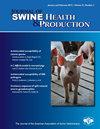Swine behavioral and physiological response to increasing sodium nitrite oral drench administration and resulting tissue residues
IF 0.7
4区 农林科学
Q3 Agricultural and Biological Sciences
引用次数: 1
Abstract
Objectives: This study aimed to evaluate the physiological and behavioral responses of pigs administered sodium nitrite, determine an ideal dosing rate by oral drenching of sodium nitrite for depopulation events, and evaluate the nitrite residue present in the ocular fluid and skeletal muscle after sodium nitrite administration. Materials and methods: Four groups of 10 market weight pigs (40 market weight pigs total) and 1 group of 10 sows were used. Each group of market weight animals received a different oral drench dose of sodium nitrite solution (1× [400-441 mg/kg], 2× [800-882 mg/kg], 2.5× [1000-1102 mg/kg], and 3× [1200-1323 mg/kg]) and was observed for distress behaviors. Two market weight animals in each treatment group were implanted with a monitor to measure body temperature, heart rate, and activity levels. The dosing rate with apparent best behavioral and physiological response was applied to the 10 sows and the same behaviors monitored. After death was confirmed, ocular fluid and skeletal muscle samples were collected from the sows. Results: An increased dosage of sodium nitrite greatly reduced the time to distress with a significant linear relationship. A higher frequency of vocalizations and the most frequent spikes in activity levels were observed in the lowest dosing group. No correlation was found between ocular fluid nitrite and skeletal muscle sodium nitrite concentrations. Implications: Oral drenching of sodium nitrite is a viable method for swine depopulation events. Higher doses of sodium nitrite have better welfare associations. Ocular fluid nitrite anion concentrations do not correlate with sodium nitrite skeletal muscle concentrations.猪对增加亚硝酸钠口服淋剂剂量及其组织残留的行为和生理反应
目的:本研究旨在评估亚硝酸钠对猪的生理和行为反应,通过口服亚硝酸钠确定减少种群事件的理想剂量率,并评估亚硝酸钠给药后眼液和骨骼肌中的亚硝酸钠残留。材料与方法:选用4组10头市重猪(共40头市重猪)和1组10头母猪。每组市重动物口服不同剂量亚硝酸钠溶液(1× [400-441 mg/kg]、2× [800-882 mg/kg]、2.5× [1000-1102 mg/kg]、3× [1200-1323 mg/kg]),观察其应激行为。每个治疗组2只市售体重动物植入监测器,测量体温、心率和活动水平。采用表现出最佳行为和生理反应的给药率,对10头母猪进行相同的行为监测。在确认死亡后,从母猪身上采集眼液和骨骼肌样本。结果:增加亚硝酸钠剂量可显著缩短患者的痛苦时间,并呈显著的线性关系。在最低剂量组中观察到更高的发声频率和最频繁的活动水平峰值。眼液亚硝酸盐与骨骼肌亚硝酸钠浓度无相关性。意义:口服亚硝酸钠是处理猪群减少事件的可行方法。高剂量的亚硝酸钠有更好的福利关联。眼液亚硝酸盐阴离子浓度与亚硝酸钠骨骼肌浓度无关。
本文章由计算机程序翻译,如有差异,请以英文原文为准。
求助全文
约1分钟内获得全文
求助全文
来源期刊
CiteScore
1.80
自引率
0.00%
发文量
29
审稿时长
>36 weeks
期刊介绍:
The Journal of Swine Health & Production (JSHAP) is an open-access and peer-reviewed journal published by the American Association of Swine Veterinarians (AASV) since 1993. The aim of the journal is the timely publication of peer-reviewed papers with a scope that encompasses the many domains of applied swine health and production, including the diagnosis, treatment, management, prevention and eradication of swine diseases, welfare & behavior, nutrition, public health, epidemiology, food safety, biosecurity, pharmaceuticals, antimicrobial use and resistance, reproduction, growth, systems flow, economics, and facility design. The journal provides a platform for researchers, veterinary practitioners, academics, and students to share their work with an international audience. The journal publishes information that contains an applied and practical focus and presents scientific information that is accessible to the busy veterinary practitioner as well as to the research and academic community. Hence, manuscripts with an applied focus are considered for publication, and the journal publishes original research, brief communications, case reports/series, literature reviews, commentaries, diagnostic notes, production tools, and practice tips. All manuscripts submitted to the Journal of Swine Health & Production are peer-reviewed.

 求助内容:
求助内容: 应助结果提醒方式:
应助结果提醒方式:


